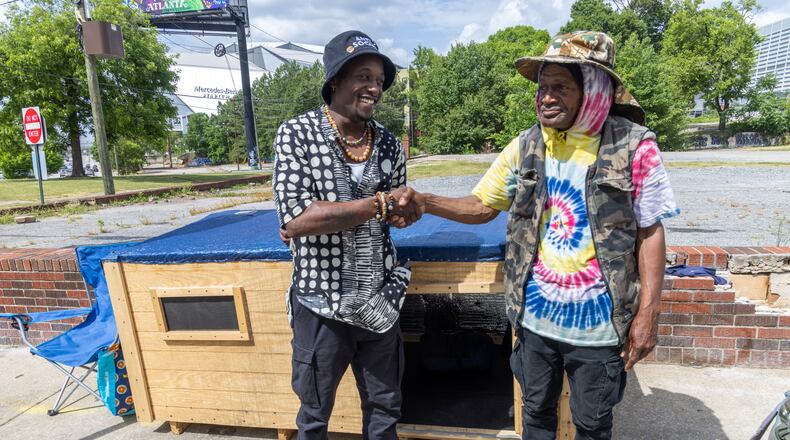Reginald Driskell lived in a cardboard box about the size of a refrigerator at the corner of Northside Drive and Tatnall Street in southwest Atlanta.
He’d lived on the streets for 25 years, the last 17 in this neighborhood near Mercedes-Benz Stadium. He’d long ago given up hope that the homeless shelter a couple of blocks away would have room for him.
Then last year, he caught the eye of Brandon Brando, a music artist and production assistant, who had just moved to Castleberry Hill.
Brando would see Driskell in his cardboard box while on walks through the neighborhood or on his way to the local convenience store. Sometimes, he would hand Driskell a few dollars. Other times, he would give him food, spare clothes and hygiene products.
“I like to get personal with people, especially if I’m seeing you in my neighborhood,” Brando said.
Slowly, he learned tidbits about Driskell’s life. The 64-year-old told him he was born at Grady Hospital, grew up in this neighborhood, served in the military, traveled the world, and worked for years in the city’s food service industry.
Credit: AJC
Credit: AJC
The more Brando learned about Driskell, the more he started to care about him.
He found himself wondering: What would Driskell do in a thunderstorm with only a cardboard box and blue tarp roof to shield him? Did Driskell really have to lug black trash bags full of everything he owned just to get a cup of coffee down the street? Or was he right in fearing that, otherwise, all his belongings would be stolen?
Brando began giving Driskell the occasional MARTA pass, so he’d at least have somewhere to go on rainy days. But he wanted to do more.
Brando, who works two jobs and lives paycheck-to-paycheck, decided he would build the man he calls “Mr. Reginald” a better, safer place to live.
Credit: AJC
Credit: AJC
He enlisted the help of his uncle, John Brown, and started work on the tiniest of tiny homes for Driskell.
For 3½ weeks, he spent his spare time building the roughly 7-foot-by-3½-foot wooden structure he calls a “live station.”
“I don’t make a lot of money, and sometimes I would use my last to buy materials,” Brando said.
He quickly blew through his original $150 budget. But what he created was a space large enough for Driskell to lay down, sit up, safely store all his belongings, and stay out of the elements.
And he went to great lengths to make sure the tiny structure was comfortable. He thoroughly insulated it and used two USB-powered cooling fans, one on each side of the unit, for air circulation. The fans connect to a solar rechargeable power brick, the type that is typically used to charge multiple devices.
He even developed a plan so the fans can be removed from the windows and replaced with solid coverings during inclement weather. The tiny dwelling also has two solar-powered LED lights inside that are attached to solar cells on the roof.
Everything in the structure is new, except the blue tarp roof.
“I wanted him to feel like he still had a part of his old place,” Brando said.
Driskell moved into the live station on May 18. And he’s happy to be there.
“I like it very well,” Driskell said. “It’s helping a whole lot.”
Now, he said, he no longer worries that dogs or strangers might approach him as he sleeps. And when he goes out, he only takes one bag with him and leaves the rest locked inside his new home.
Brando wants to build more and bigger live stations. He says he should be able to cut the costs – which ended up totaling $898 – and time in the future since Driskell’s place was built largely by “trial and error.”
Eventually, Brando would like to develop a whole community of these small structures and change the mindset from “homeless to less home,” but he hasn’t begun to try to determine what all that would involve.
“I want to be able to provide these for the homeless in this community, in this city,” Brando said. “I find it outrageous the amount of money that is here, the amount of homelessness that is here, and there’s nothing done about it.”
Karla McDuffie, a friend from Roanoke, Virginia, said she was not surprised when she heard Brando was taking on this project.
“He’s a cool person to know, an unusual ‘average Joe’ who cares deeply about humanity and is taking action to make a contribution to his community,” she said.
Brando said he has been challenged in the past with drug abuse problems and, at times resorted to sleeping in his car or on a friend’s couch.
“Now after knowing Mr. Reginald’s story, I can honestly say I wasn’t homeless,” said Brando, who works in art/set design, production logistics, songwriting, music production, and as a production assistant.
As for his desire to help others, he says, that was likely “in the cards.”
Credit: AJC
Credit: AJC
“My parents have always looked out for just anybody who needs some help,” Brando said.
Read more about Brando and his vision for helping the homeless at www.imbrandonbrando.com.
About the Author
Keep Reading
The Latest
Featured




